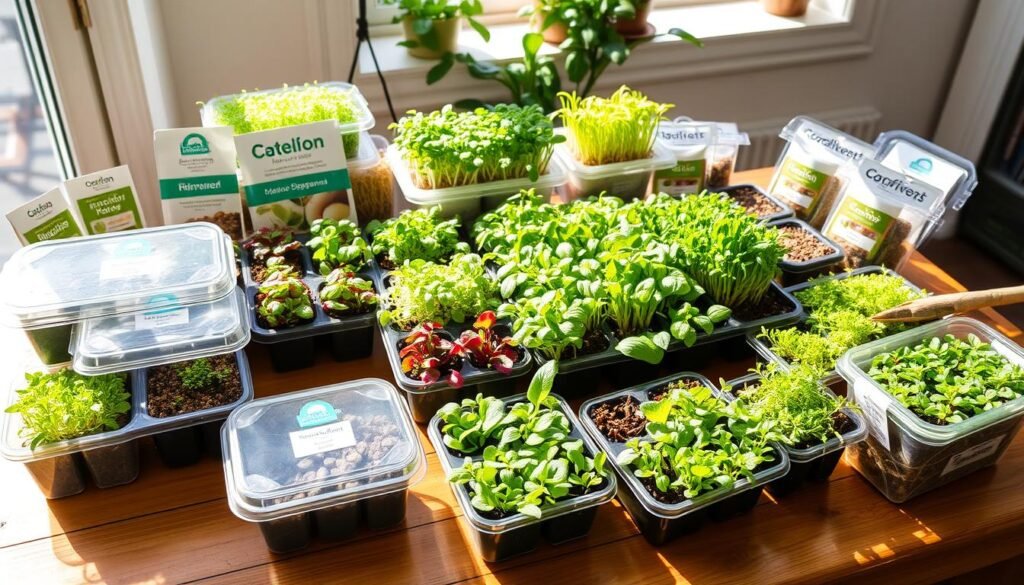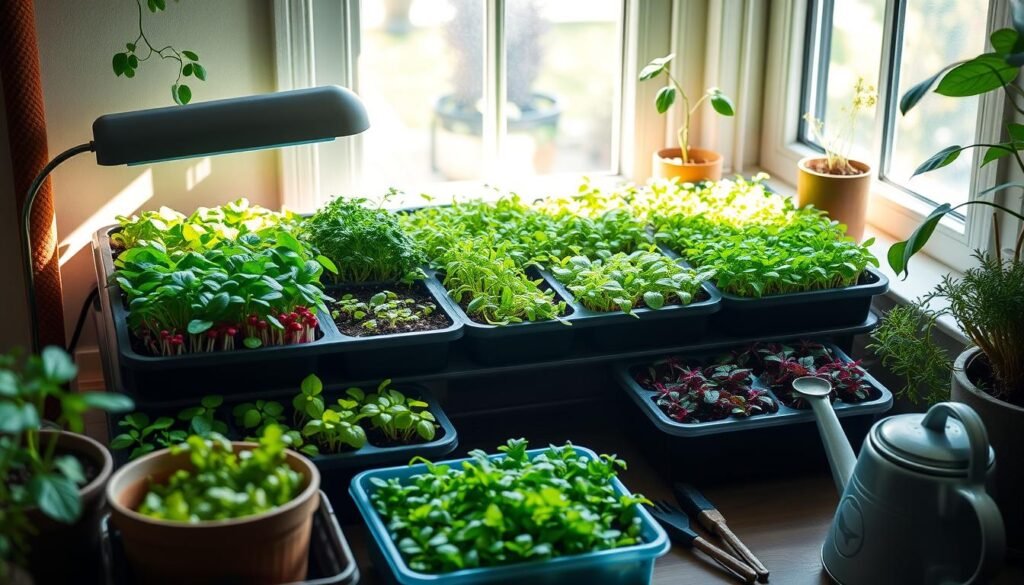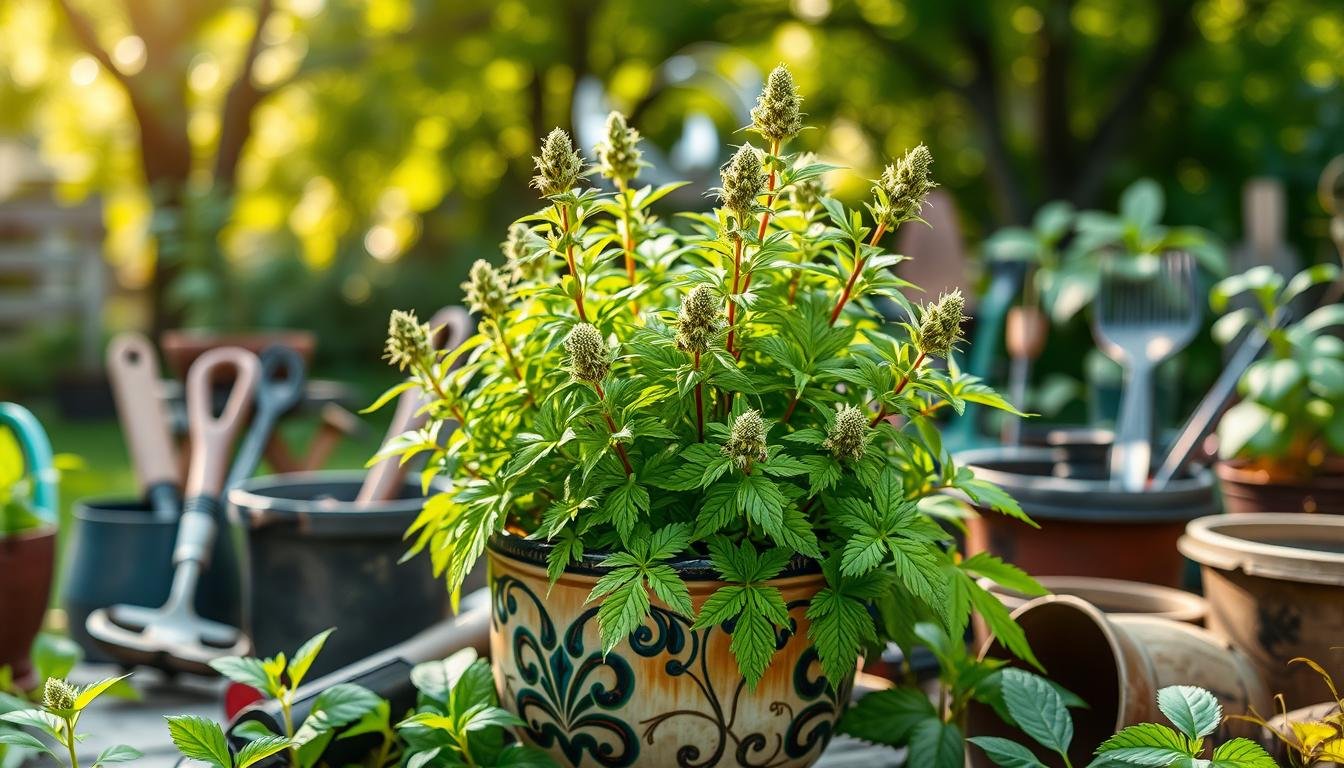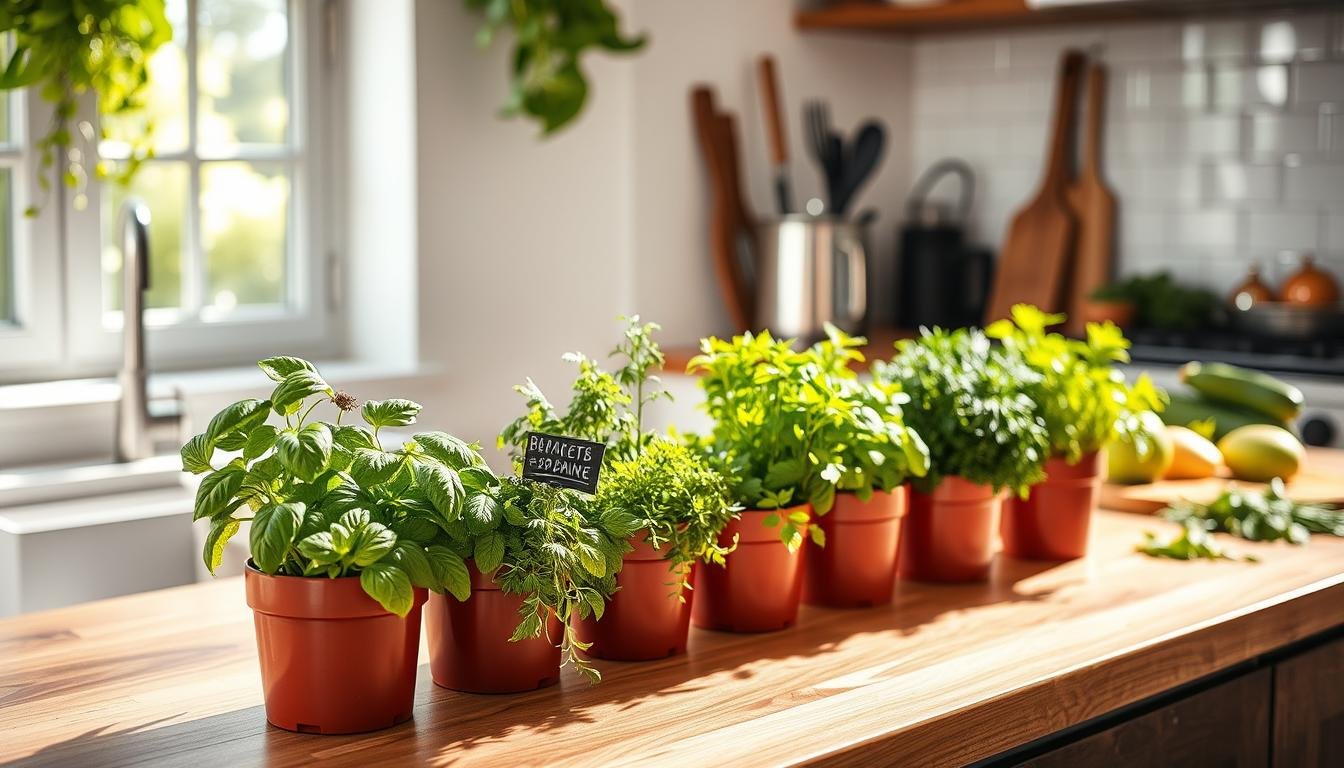More than 80% of American homes now enjoy indoor gardening. It boosts their quality of life. They find joy in growing fresh greens at home. A microgreens kit is perfect for beginners and food lovers alike. It makes starting a garden simple and fun for everyone.
Brands like Urban Cultivator and Back to the Roots offer great microgreens kits. These kits let you easily grow vibrant greens on your countertop. Adding them to your meals boosts flavor and health. So why not start? A microgreens kit can turn your place into a green haven.
Key Takeaways
- Indoor gardening is increasingly popular, with over 80% of U.S. households participating.
- A microgreens kit makes it easy to grow nutritious greens at home.
- Brands like Urban Cultivator and Back to the Roots offer user-friendly starter kits.
- Growing microgreens enhances flavor and provides significant health benefits.
- Starting an indoor microgreens garden is accessible and rewarding for all skill levels.
What Are Microgreens and Their Benefits?
Microgreens are young plants picked just after their first true leaves show. They offer more vitamins and minerals than full-grown plants. Many types of seeds, like arugula, basil, and radishes, are used. Knowing about microgreens helps understand their big benefits in food and health.
Understanding Microgreens
Microgreens add more than beauty to your plate. They bring strong flavors and colors to any meal. With easy-to-start kits, growing them at home is simple. This makes these nutritious greens available to all.
Health Benefits of Growing Your Own
Growing your own microgreens boosts your health. They’re full of vitamins, minerals, and antioxidants. These greens have 4 to 40 times the nutrients than mature ones.
Eating them adds fiber to your diet and makes meals tastier. This leads to eating better. Growing microgreens can also make you feel good mentally.
| Type of Microgreen | Nutritional Benefit | Common Uses |
|---|---|---|
| Arugula | High in calcium and potassium | Salads and sandwiches |
| Basil | Rich in antioxidants and vitamin K | Pesto and pizzas |
| Radish | Contains fiber and vitamin C | Garnishes and wraps |
| Sunflower | High in protein and healthy fats | Smoothies and salads |
Choosing the Right Microgreens Kit
Choosing the right microgreens kit is key to a great gardening journey. By knowing what’s out there and what to look for, you’re on your way to a smart choice.
Types of Microgreens Kits Available
There’s a variety of microgreens kits designed for different tastes and spaces. Among them are:
- Soil-based kits: Best for those with a bit of window space, giving plants a natural place to grow.
- Hydroponic systems: A top pick for city folks, like those by GrowLED. No soil mess and they save on space.
- Self-watering kits: Perfect for the always-on-the-go people. These kits cut down on upkeep while keeping water levels just right.
Factors to Consider When Buying
Looking for the best microgreens kit? Think about these points:
- Space requirements: Look at your available space for growing these greens.
- Lighting conditions: Make sure you know how much light you get or consider kits with built-in lighting.
- Seed variety preferences: Some kits come with certain seeds, others let you choose your own.
- Size and complexity of the kit: Pick a kit that suits your gardening skill level and living space.
- Crop growth duration and maintenance: Go for a kit that matches your daily routine and how much you enjoy gardening.
Better supplies make microgreen gardening more fun and fruitful. With the right gear and info, you can easily grow beautiful green plants at home.

| Type of Kit | Advantages | Ideal For |
|---|---|---|
| Soil-based | No mess, natural growth | Homes with window space |
| Hydroponic | Space-efficient, clean | Urban apartments |
| Self-watering | Low maintenance | Busy individuals |
Microgreens Kit: Essential Growing Supplies
Starting a microgreens garden means picking high-quality supplies. The right tools can make a big difference in your garden’s success. Consider things like soil, nutrients, and the best seeds for microgreens.
Soil and Nutrients for Your Microgreens
A good soil mix is key for healthy plants. Peat moss and coconut coir are great since they hold water and drain well. Add nutrients for microgreens to boost growth and health. Some microgreens might need extra fertilizers for vital vitamins and minerals.
Seeds to Consider for Your Kit
Selecting the best seeds is crucial for a great harvest. Favorites include cilantro, peas, and mustard greens, which all taste and feel different. Many seed kits offer a mix of seeds, tailored for growing indoors. Companies like True Leaf Market have lots of options. They let gardeners pick seeds that suit their tastes and needs.
Setting Up Your Indoor Microgreens Garden
Setting up your indoor microgreens garden right is key. You need to think about where it goes, the light it gets, and how you’ll water it. This helps your plants grow well and give lots of good stuff to harvest.
Choosing the Right Location
Where you grow your microgreens really matters. Find a spot with lots of natural light. A window facing south is best. If you don’t have enough sunlight, you might need to use special lights for plants. Make sure your garden’s spot keeps a steady temperature and humidity.
Light Requirements for Healthy Growth
Microgreens need a lot of light, about 12-16 hours a day. You can use different kinds of lights or just sunlight. Be careful how close your lights are to the plants. Too much light can burn them, and not enough can make them weak.
Watering Techniques for Success
Watering microgreens is different from other plants. Mist them in the morning so they’re ready for light. Feel the soil to see if it’s dry before you water again. This keeps your plants from getting too wet or dry. The right amount of water is important for healthy plants.
| Factor | Considerations |
|---|---|
| Location | Choose a well-lit area; south-facing windows work best. |
| Light Source | Use LED grow lights, fluorescent lamps, or natural light. |
| Light Duration | Provide 12-16 hours of light for optimal growth. |
| Watering Method | Mist plants in the morning to avoid over-saturation. |
| Moisture Check | Touch the soil to gauge moisture levels before watering. |
Step-by-Step Guide to Planting Microgreens
Planting microgreens is both fun and rewarding. It all starts with preparing your microgreens kit the right way. Make sure everything is clean to avoid any unwanted guests. Then, fill up your trays with your growing medium, but only three-quarters of the way. This makes sure seeds spread out evenly and grow the same way.
Before planting, lightly moisten the soil. This trick makes the seeds stick better, which is important for starting to grow. Once your trays are ready, spread the seeds across the surface. Just make sure each one has enough space according to the guidelines.
Preparing Your Microgreens Growing Kit
After seeding, cover them with a little bit of soil. Then, water them gently again to keep the moisture just right. Watching the light and humidity levels closely is key. Doing this daily helps growing healthy microgreens, ensuring they get what they need every step of the way.
Sowing Seeds and Maintaining Healthy Growth
Don’t forget about your plants after planting. Keep the soil moisture in check and tweak it if necessary. A steady supply of light is another must-have for growth. With a bit of attention and the right conditions, your microgreens will grow strong. Soon, you’ll have your very own fresh, packed-with-goodness greens at home.
| Step | Action |
|---|---|
| 1 | Wash all growing supplies |
| 2 | Fill trays with growing medium (3/4 full) |
| 3 | Moisten the soil lightly |
| 4 | Sow seeds evenly |
| 5 | Cover seeds with a thin layer of soil |
| 6 | Water seeds gently |
| 7 | Monitor humidity and light |
Common Challenges in Microgreens Cultivation
Growing microgreens indoors has its hurdles. Knowing these challenges and how to overcome them can make things better. This part will cover pest management in microgreens and usual errors to steer clear of.
Pest Management in Indoor Gardens
Even the best indoor gardens can face pests. Aphids and fungus gnats often surprise gardeners. Effective pest management microgreens plans are critical for plant health. Organic methods can reduce pest problems. Also, growing certain plants together can keep pests away. For example, basil near microgreens can stop pests and make food tastier. Understanding these issues helps you protect your plants better.
Common Growing Mistakes to Avoid
Beginners in gardening can make mistakes that frustrate them. One common issue is planting seeds too close, which leads to competition for light and nutrients. Insufficient light or uneven watering can harm plants. Too much fertilizer can also hurt young plants. Recognizing these mistakes in growing microgreens lets gardeners fix issues. By following the right steps, gardening becomes more rewarding.

Harvesting and Enjoying Your Fresh Microgreens
Harvesting microgreens is a rewarding part of indoor gardening. It’s important to know the best time for harvest. This ensures they are flavorful and nutritious. Microgreens are usually ready between 7 to 21 days after planting. The appearance of the first true leaves is a clear signal. Using scissors for harvesting is best for a clean cut. This method keeps your microgreens fresh and clean.
When to Harvest Your Microgreens
To pick the perfect time to harvest, watch your microgreens grow. You should look for:
- First true leaves: These tell you they’re ready.
- Height: They should be between 1-3 inches tall.
- Color and vibrancy: Brightness means great flavor and freshness.
Creative Ways to Use Microgreens in Your Meals
Microgreens add excitement to your meals. They bring color and taste that make food better. Here are some ways to use them:
- Topping for salads: They add a fresh touch.
- Sandwich garnish: They can make sandwiches special.
- Soup enhancer: They add flavor and texture to soups.
- Smoothie boost: Mixing them into smoothies adds nutrients.
Trying different types of microgreens is fun. It lets you find new tastes for your foods. This can make cooking more exciting and improve your meals.
| Microgreen | Flavor Profile | Best Uses |
|---|---|---|
| Radish | Pungent, spicy | Salads, sandwiches |
| Sunflower | Nutty, sweet | Soups, smoothies |
| Pea Shoots | Sweet, crisp | Salads, stir-fries |
| Basil | Fresh, aromatic | Pasta, pizza |
DIY Microgreens Kit: A Fun Project for Everyone
Building your own DIY microgreens kit is a fun activity for the family. You will need trays, seeds, soil mix, and a light source. Local gardening stores or your home might have what you need. This project is not only educational but also lets you get creative with your setup. By following this guide, you can start enjoying indoor gardening.
Creating Your Own Microgreens Growing Kit
Start your microgreens kit by collecting some basic gardening supplies. You will need:
- Seed trays: Look for plastic or biodegradable trays.
- Microgreens seeds: Choose varieties such as broccoli, radish, or sunflower.
- Soil mix: Select a lightweight potting mix designed for seed starting.
- Light source: A simple LED grow light or natural sunlight works well.
Doing this project lets you control your growing environment and have fun. Making your kit can save money and makes you think about sustainable habits.
Cost-Effective Options for Home Gardeners
For an affordable microgreens kit, look for these cost-saving ideas:
| Items Needed | Cost-Effective Alternatives |
|---|---|
| Seed trays | Repurpose shallow containers from takeout or bakery items. |
| Seeds | Purchase in bulk or look for seed packets at local garden centers. |
| Soil mix | Make your own soil mixture with compost and peat moss. |
| Light source | Use natural light from a south-facing window. |
By following these tips, you can build a budget-friendly microgreens kit. Growing your own food is rewarding and can lead to a healthier living.
Scaling Up Your Indoor Microgreens Garden
You’ve got the basics of growing microgreens down, and now you’re ready for more. Expanding your microgreens garden is exciting. You might want to grow more in a larger space or try different varieties. With the right steps, your indoor garden will thrive with fresh greens.
Think about trying vertical gardens or hydroponic systems. These methods save space and help your plants grow more. By using these systems, you can get the most from your microgreens kit. They help you grow more greens in less space, which is great for your indoor garden.
Maybe you end up growing more microgreens than you need. If so, consider starting a small business from home. You could sell your greens to local restaurants or at farmers’ markets. This could turn your gardening hobby into a way to make money and share with your community.



